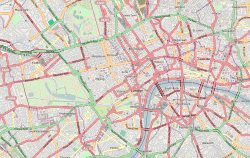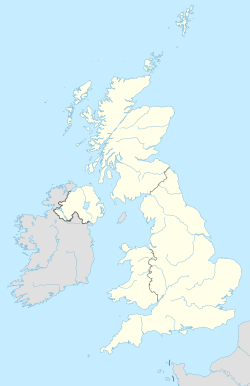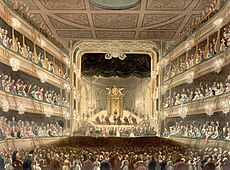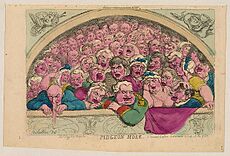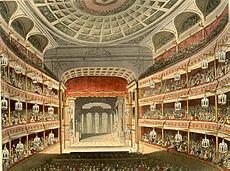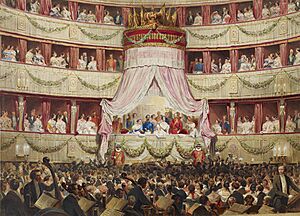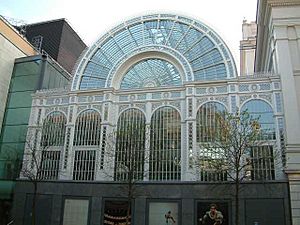Royal Opera House facts for kids
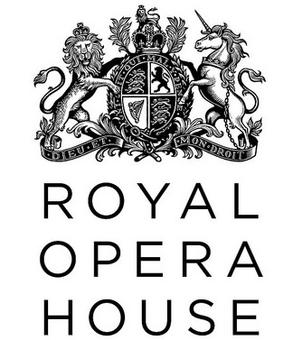 |
|

Bow Street frontage with Plazzotta's statue, Young Dancer, in the foreground
|
|
| Former names | Theatre Royal, Covent Garden (until 1892) |
|---|---|
| Address | Bow Street |
| Location | London, WC2 |
| Coordinates | 51°30′47″N 0°7′22″W / 51.51306°N 0.12278°W |
| Public transit | Bus: 6, 11, 14, 26, 59, 98, 139, 168, 176 |
| Owner | Royal Opera House Covent Garden Foundation |
| Designation | Grade I |
| Type | Opera house |
| Genre(s) | Classical |
| Capacity | 2,256 (main auditorium) |
| Construction | |
| Built | 1728–1732 (original building) |
| Opened | 7 December 1732 |
| Architect | Edward Shepherd (original building) Edward Middleton Barry (current building) |
| Builder | Lucas Brothers (current building) |
| Tenants | |
| The Royal Ballet The Royal Opera |
|
The Royal Opera House (ROH) is a famous theatre in Covent Garden, central London. People often call it simply Covent Garden. It is the main home for The Royal Opera, The Royal Ballet, and the Orchestra of the Royal Opera House. These groups are now known together as the Royal Ballet and Opera.
The first theatre on this spot, called the Theatre Royal, opened in 1732. For its first 100 years, it was mostly a place for plays. In 1734, the first ballet was performed there. A year later, the famous composer George Frideric Handel started presenting his operas. Many of his works were written especially for Covent Garden.
The building you see today is the third theatre on this site. The first two were destroyed by big fires in 1808 and 1856. The front of the building, the main entrance area, and the audience seating area are from 1858. However, most of the rest of the building was rebuilt in the 1990s.
The main seating area holds 2,256 people. This makes it one of the largest theatres in London. It has four levels of private boxes and balconies, plus an upper gallery. The stage opening is about 14.8 meters wide and 12.2 meters high. The main auditorium is a Grade I listed building, meaning it's a very important historic building. In 2024, the companies that perform here changed their public name to the Royal Ballet and Opera. But the building itself is still called The Royal Opera House.
Contents
History of the Royal Opera House
Early Beginnings and First Theatre

The story of the Theatre Royal, Covent Garden began in 1662. King Charles II gave a special permission, called a "letters patent," to Sir William Davenant. This allowed him to run one of only two theatre companies in London. This special permission stayed with the families of the original owners for a long time.
In 1728, a theatre manager named John Rich had a huge success with an opera called The Beggar's Opera. This success gave him enough money to build a new theatre. He chose a spot where an old convent garden used to be. This area was also known for its fruit and vegetable market, which stayed there until 1974.
The first theatre opened on December 7, 1732. John Rich was carried into the building by his actors for the first show. For its first 100 years, this theatre was mainly for plays. The special permission from King Charles II meant that only this theatre and the Theatre Royal, Drury Lane could perform spoken plays in London.
John Rich also brought pantomime shows to the theatre. He even performed in them himself as the character Harlequin. Pantomime shows continued to be a tradition at the theatre until 1939.
In 1734, the theatre showed its first ballet, Pygmalion. The dancer Marie Sallé surprised everyone by dancing in light, flowing clothes instead of a traditional corset. In 1734, George Frideric Handel began his first season of operas at the theatre. Many of his famous operas and oratorios were written for this theatre. Handel performed there regularly until he died in 1759. Sadly, a fire destroyed this first theatre on September 20, 1808.
The Second Theatre and New Innovations
Work on the second theatre began in December 1808. It opened on September 18, 1809, with a performance of Macbeth. The theatre manager, John Philip Kemble, raised ticket prices to cover the rebuilding costs. This made audiences very angry, leading to the "Old Price Riots" which lasted over two months. Eventually, the theatre had to lower its prices.
During this time, the theatre offered many different types of entertainment. Famous actors like Sarah Siddons and Edmund Kean performed there. The great clown Joseph Grimaldi also became very famous at Covent Garden. He was known for his physical comedy and funny tricks. Grimaldi helped create the modern idea of a clown.
In 1817, gaslights were installed on the stage, replacing candles and oil lamps. This was a big improvement. Later, in 1837, a new type of lighting called limelight was used for the first time. Limelight used a very bright flame to create spotlights, which could highlight performers on stage.
In 1843, a new law meant that other theatres could also perform plays. Before this, only Covent Garden and Drury Lane had that right. In 1846, a conductor named Michael Costa moved from another theatre to Covent Garden, bringing many performers with him. The theatre was then completely rebuilt after another fire in 1856. It reopened as the Royal Italian Opera on April 6, 1857.
For many years, all operas were performed in Italian, even if they were originally in other languages. This changed in 1892 when Gustav Mahler presented Wagner's Ring cycle. After that, the word "Italian" was removed from the theatre's name.
On March 5, 1856, after a big party, the theatre caught fire again and was destroyed.
The Third and Current Theatre
Work on the third theatre began in 1857. This new building, designed by Edward Middleton Barry, is the main part of the theatre we see today. It opened on May 15, 1858, with an opera called Les Huguenots.
The theatre officially became the Royal Opera House (ROH) in 1892. It started to feature more French and German operas. The building was also used for pantomimes, concerts, and even political meetings.
During the First World War, the theatre was used to store furniture. During the Second World War, it became a dance hall. After the war, a music company bought the lease. They wanted to make Covent Garden the national center for opera and ballet, using British artists.
The Royal Opera House reopened on February 20, 1946, with a beautiful performance of The Sleeping Beauty. The Royal Opera House companies then began to build their own groups of performers.
Modern Renovations and Changes
By the 1970s, the theatre needed a big update. In 1975, the government provided land next to the Royal Opera House for a major renovation. In the early 1980s, new ballet studios, offices, and rehearsal rooms were added.
In the 1990s, a huge £213 million reconstruction project took place. This involved tearing down almost the entire site, except for the main auditorium. More than half of the complex was brand new. The goal was to create a modern theatre with better facilities.
The new building kept the traditional horseshoe-shaped auditorium. But it added much better technical areas, rehearsal spaces, offices, and educational facilities. A new smaller theatre, the Linbury, was also created. The old Floral Hall, which was once a flower market, was also restored and became a large public gathering space. The Royal Opera House now says it is the most modern theatre in Europe.
Since 1983, surtitles (translations projected above the stage) have been used for all opera performances. Since 1999, some seats have small video screens that show translations.
In 2014, a project called "Open Up" began. This project aimed to make the theatre more open to the public during the day. It also improved the entrances, lobby areas, and the Linbury Theatre.
In October 2020, the Royal Opera House faced financial challenges due to the global pandemic. To help ensure its survival, a famous painting by David Hockney was sold for £12.8 million.
In 2023, members of the orchestra were chosen to play at the coronation of Charles III and Camilla.
In 2024, the public name for the Royal Opera House's companies changed to Royal Ballet and Opera. This was done to show that both the ballet and opera companies are equally important. The building itself is still called the Royal Opera House.
In March 2025, the Royal Opera House received several nominations for the Laurence Olivier Awards. One notable nomination was for Festen in the Best New Opera Production category.
In July 2025, a disagreement occurred during a curtain call after a performance of Giuseppe Verdi’s Il Trovatore. A performer brought a flag onto the stage. An opera director tried to take the flag, and later told the performer they would not work at the opera house again. The Royal Ballet and Opera stated that the performer's actions were "completely inappropriate." Later, in July 2025, many members of the Royal Ballet and Opera signed a letter. They expressed concern about the organization's decisions regarding performances in Israel. They asked the Royal Ballet and Opera to stop performing in Israel. In response, on August 4, 2025, the chief executive announced that a new production of Tosca would not be going to Israel.
Facilities at the Royal Opera House
Paul Hamlyn Hall
The Paul Hamlyn Hall is a large building made of iron and glass. It is next to the main opera house and connects directly to it. This hall is now the main public area of the opera house. It has a champagne bar, a restaurant, and other services for visitors. It also provides access to the main auditorium on all levels.
This building was once called the Floral Hall. It was built in 1860 to house a flower market. After a fire in 1956, it was left empty for many years. The Opera House bought it in 1977 and used it for storage.
During the 1990s renovation, the iron structure of the Floral Hall was lifted up. This created new public areas underneath for the opera house. Part of the hall's iron structure was moved and rebuilt in Borough Market.
The hall was first named the Vilar Floral Hall after a large donation. However, the donation was not fully paid. So, in 2005, it was renamed the Paul Hamlyn Hall after another generous donation.
Besides being a public area for performances, the Paul Hamlyn Hall is also used for many other events. These include private parties, dances, exhibitions, concerts, and workshops.
Linbury Studio Theatre
The Linbury Studio Theatre is a flexible performance space located underground within the Royal Opera House. It has seats that can be moved and a floor that can be raised or lowered. This allows it to be used as a studio, a raised stage, or a stage with an orchestra pit.
The theatre can hold up to 400 people. It is used for many different events, including theatre shows, concerts, and educational programs. It is one of the most technologically advanced performance venues in London. It has its own public areas, including a bar and cloakroom.
The Linbury is especially known for showing new and experimental dance and music. It also hosts performances by the Royal Ballet School. The theatre was built during the 1990s renovation. It is named after the Linbury Trust, which made a large donation for the redevelopment.
High House Production Park (Purfleet)
The Royal Opera House opened a facility in Purfleet, Essex, on December 6, 2010. This is where they make the scenery for their operas and ballets. This building is called the Bob and Tamar Manoukian Production Workshop.
In September 2015, the Bob and Tamar Manoukian Costume Centre also opened there. This center makes costumes for the Royal Opera House. It also trains students in costume-making. The building stores the Royal Opera House's collection of important historical costumes.
Other parts of the High House Production Park include The Backstage Centre. This is a training center for technical theatre and music. There are also artist studios there.
Other Uses of the Royal Opera House
Besides opera and ballet, the Royal Opera House has hosted other important events:
- British Academy Film Awards – from 2008 to 2016
- Laurence Olivier Awards – from 2012 to 2016
See also
 In Spanish: Royal Opera House para niños
In Spanish: Royal Opera House para niños
- Owners, lessees and managers of the Royal Opera House, Covent Garden
- European Route of Historic Theatres


